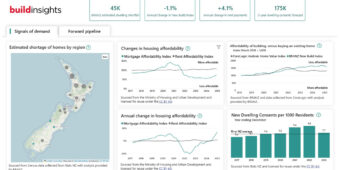NIMBLE AND QUICK
29 Oct 2020, Business Tips, Learn, Prove Your Know How

Facing big changes in your market might tempt you to make sudden changes to how you do business. But any changes should be based on sound thinking and reliable information, as business coach Graeme Owen explains
Whatever your opinion of the Government’s handling of Covid-19, you likely felt most comfortable with those actions that you believed were based on the best available evidence – even if you didn’t always agree with the plans made
But you would have reacted quite differently if, instead, those decisions had simply been made on the run with no input from specialists and no evaluation of evidence – simply decided on the whim of an official! You would have been most alarmed. No responsible government would do that.
Yet, at the moment and during these changing times, are you making your business plans based on excellent information? Or are you making your decisions on the run, based on your intuition, press opinions and rumours?
Recently, we have been hearing much about the importance of businesses being nimble and pivoting (new terms for some of us). Simply put, these terms mean that to cope well with the rapidly changing Covid-19 environment you need to make modifications to your products and service offerings quickly – and strategically to suit the changing market demands.
Think of those companies that immediately switched to making masks, or who adapted their business to service the now huge courier demands. I suspect these were strategic decisions based on the best available information about what opportunities the Covid-19 environment would likely bring.
So what good information does your business need to ensure you can pivot safely and nimbly?
1 Market Needs
You can learn about the changing needs of your market by listening carefully to the requests you get for products and services. This may seem obvious, but few business owners do this intentionally.
For example, let’s say you knew that prior to Covid-19, you didn’t get many requests for bathroom renovations. But now you are getting many. If this were the case would you want to make any changes to your business model? Maybe. But first you would want to know if that trend is really increasing or simply a temporary blip.
If you had been recording that information for the last year, you would be able to determine the trend more accurately and make any decisions with a measure of confidence. Further, should the trend reverse (and you would identify that early) you could make further adjustments. Of course, it doesn’t remove the risk entirely, but it does reduce the higher risks of ad-hoc decision making.
So if you are not already recording client needs, start by creating a short list of likely job requests and record each caller in one of these categories. Do monthly summaries and compare month to month and quarter to quarter. In just a few months you will start seeing trends in client needs and be better able to pivot to meet these.
2 Sources of Business
Covid-19 has changed the way we interact socially and the types of media we engage with. How many people now know about Zoom who didn’t know about it pre-Covid-19?
Just so, it makes sense to know if the place from where you have been getting your business leads has changed! Because then you can pivot your advertising. You can choose to quit the advertising that is not working and try new strategies or new places.
However, if you don’t know where your leads are coming from, then you may be missing opportunities or, worse, wasting time and money “speaking to people who have left the room!”
If you are not tracking the source of your new leads, start recording these immediately. Then as early as possible in your conversation ask your new lead, “By the way, how did you find out about us?” and record what they tell you. This information will help you identify clearly those advertising channels that are working and those that are not. You may be surprised. This both saves you money and ensures a steady number of leads into your business.
Now, please don’t simply record,“word of mouth” as it provides very little usable information. While it might sound good, it just raises a whole lot of further questions. E.g. Whose mouth? (Who told them? Family? Colleague? Professional?); What words? (What message did they convey?); Where were they spoken? (Social setting? Work? Professional office? Networking event? etc); When did they hear? (Before, during or after the build?)
But when you do know how your new leads are finding you, you can determine where to re-focus your advertising. Being nimble in advertising is the best way to ensure a steady flow of future work.
3 Changing Profit Centres
There are many other areas where you may want to tweak your business because of changes in the marketplace. E.g. Changes in the availability of new team members; in the availability of subcontractors; in the costs of materials; in delivery times, etc. All of these will have an impact on your business profits and should be factored into your business plans. You may need to adjust your schedules, pricing and/or charge out formulae to off-set these changes.
But these changes are best made based on up-to-date business information from your dashboard.
If you do not run a business dashboard, now is the time to start one.
Keep it simple to begin with. Start with back-costing each and every job: subtract the total costs from the total charged and compare with other similar jobs and with what you quoted or estimated. If you are not generating the gross profits you were, then you want to know as soon as possible so you can take action.
You can also compare current and past schedules. Are your jobs taking longer because of Covid-19 requirements or delays?
Also keep an eye out for materials and subcontractor price and schedule changes as these may likely cause cost increases in the future?
Once you have mastered simple back costing, you can add further complexity. Start measuring the effectiveness of various team makeups. You may find that different team mixes are better than others.
Takeaway
Being nimble and quick is not simply guess work- it’s measured actions based on available information
Graeme Owen is a builders’ business coach at thesuccessfulbuilder.com. Since 2006, he has helped builders throughout New Zealand get off the tools, make decent money, and get more time in their lives. Grab a copy of his free book: The 15 Minute Sales Call Guaranteed To Increase Your Conversion Rate: thesuccessfulbuilder.com/book-15-min-sales-call or join Trademates and connect with builders who are scaling too: www.facebook.com/groups/TradeMates
Register to earn LBP Points Sign in
2 Comments
Leave a Reply
You must be logged in to post a comment.




Costing
all done